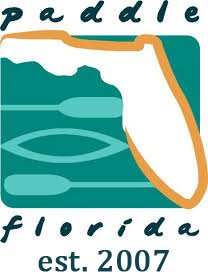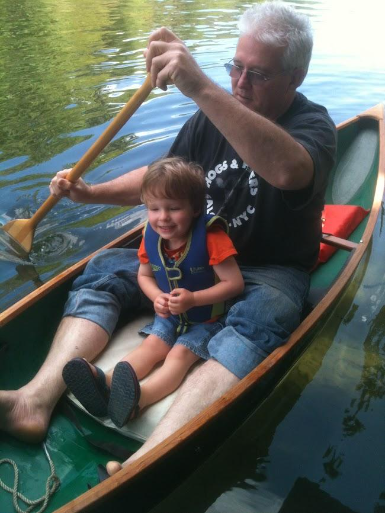Paddling Hurts
by Sandra Poucher
I don’t have many opportunities to paddle. Nowhere near as many as I imagined I would have as an adult since I grew up and live in the heart of Florida with countless freshwater waterbodies, where spring-fed rivers feed salty estuaries and larger gulfs and oceans. Where people visit from all over the world just to float in inner tubes down beautiful waterways admiring the nature and the wildlife. I consider myself lucky by location, but lazy about getting out there and paddling. I am also cautious. I’ve learned paddling has surprises, and some of those can hurt.
When I do get the opportunity, I am quickly off, away upstream as far as my out-of-shape arms can dig water. I sit cross-legged in my mother-in-law’s small green canoe or one of the cumbersome family kayaks, involuntary posture by old habit forcing me to sit up straight. And with eyes forward I peer into mesmerizing depths, aqua and cyan and turquoise or brown and tan and rust. I look to either side, through creeping jungles and swamps, between cypress knees and waving grasses. I listen to the wind and bird-song. I wonder at the flash of a fin breaking the water, the arc of an anhinga’s neck as she cranes around to watch my slow, steady progress. I smile at parents showing their children the ways of water and at youngsters racing each other with abundant splashing and sound. The sun heats my shoulders. I am cooled by fingertips stroking the soft water.
To my immediate left, a moorhen startles me with a sudden loud laugh. I smile at the orange beak and bright yellow feet. Moorhens, also called marsh hens, are more officially known as the common gallinule. These birds can be found poking around on floating vegetation. A hawk’s shriek breaks my reverie. There are others sharing the air and water. I catch my breath, swing my paddle, and carry on.
I look to my right, admiring stately cypress trees and their knobby knees. Sometimes I retrieve odds and ends of humanity that collect among the base of the cypress: a single flip-flop, an empty cellophane bag, a floating dog toy. I carefully work my way nearer the wild riverbank to retrieve that faded old beer can or a bit of Styrofoam grown green with age. I consider each piece and its history. Who dropped it? Was it dropped by neglect or surreptitiously abandoned? How long has it been here?
Occasionally we find a beer can on the river bottom, aged and occupied by a crayfish or madtom catfish. We exclaim over the brand or the logo, a can that for ten or twenty or more years evaded discovery. Discarded trash makes up a civilization’s history. What will the future people think of us? A lone pink flip flop? Blue plastic goggles with rainbow-mirrored lenses?
I am aware as I weld my paddle and scoot my craft underneath overhanging branches in pursuit of detritus, of life above me. I have seen water snakes coiled among bright green branches overhanging the water. They are rarely noticed, they blend seamlessly. When startled, their only defense is to drop into the water for a quick escape. Unless a boat happens to be directly underneath them when they fall. Then things get interesting fast. Water snakes aren’t particularly aggressive, but they will hiss and even bite when provoked, and their bite can lead to infection and allergic reactions.
Watch, too, for fishing line snagged in the branches. A great entangler of paddles, as well as birds and other wildlife, the hazards of abandoned fishing lines and hooks are well-documented. If I see line hanging or submerged within reach, I will retrieve it for disposal ashore. The egrets and limpkin thank the conscientious sportsmen who avoid casting into trees and shrubbery. The line won’t hurt you, but it can be an unpleasant entanglement.
But what I’m really here to caution paddlers about is wasps. In particular, paper wasps (genus Poilstes), who build their nests in branches overhanging the rivers. Water provides an excellent defensive location. Branches shield the nest from hot sun. Plentiful insects provide a bounty of food for growing larvae. Paper wasps build their nests bit by bit, or maybe I should say bite by bite, by taking small bites of wood, mixing with “an oral secretion” (aka saliva), and using the mixture to make a layered, waterproof nest. The wasps are very protective of their nests, as I learned after paddling into one with my face.
Paddling doesn’t have to hurt – author’s husband, Michael, with son, Ethan, a few years ago.
At the time, my son is a toddler who loves riding in front of me in the little green canoe. I enjoy hugging the bank, keeping out of the strongest current and crowds, in the coolest shade. We made our way upstream, passing under several overhanging branches. I’d noticed small nests here and there, but higher or nearer the bank. By the time I realized the size of the one I was about to hit, it was too late to change course. I grabbed my son by the back of his lifejacket and tossed him to the right side of the canoe, making him lower and leaving myself as a target of the massive nest, ahead and to my left. I was stung five or six times on my face. I leapt out of the canoe and hurried in another direction dragging the canoe and my son. The wasps did not sting him. I took a photo and shared it – I looked terrible, but luckily, I am not allergic to wasps and the swelling receded after a few hours. We have had to assist canoeists who were allergic, it is scary for visitors in an unfamiliar place and in a potentially life-threatening scenario, no matter how beautiful and serene.
Avoidance is the best practice when dealing with paper wasps. They will do fly-by warnings, but while paddling, most people are unaware of yet another tiny flying thing buzzing around. Staying out from under low-hanging branches is best.
Don’t get me started on alligators.
Check out other writings by Sandra Poucher on Amazon

